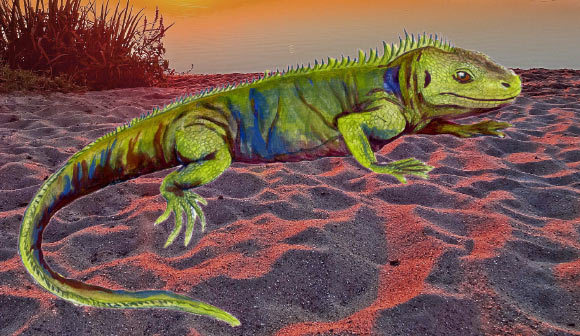A group of paleontologists, led by Catherine Klein from the University of Bristol, UK, has put together the remains of a new small species of prehistoric reptile that lived during the Triassic period, about 205 million years ago.

An artist’s reconstruction of Clevosaurus sectumsemper. Image credit: Katharine Whiteside / Sci-News.com.
The ancient creature, named Clevosaurus sectumsemper, was smaller but extremely similar to the tuatara, a living fossil from New Zealand.
Like some other members of its genus, which were found throughout the ancient world, Clevosaurus sectumsemper had self-sharpening blade-like teeth.
“With each bite the teeth are sharpened as they cut past each other very precisely. As a result, old individuals are left with sharp ridges of bone which they use as a cutting surface,” Klein explained.
“The species name sectumsemper means ‘always cut’, and was chosen to reflect this. It is also a nod to the Harry Potter character Severus Snape, who made a spell called sectumsempra (perhaps meaning sever forever).”
“The new reptile has a specially adapted dentition that allows it to tackle much larger food than would usually be expected for such a small animal, the smallest of the clevosaurs,” added team member Dr David Whiteside from the University of Bristol’s School of Earth Sciences.
The fossils of Clevosaurus sectumsemper were discovered in the Woodleaze Quarry, South Gloucestershire, United Kingdom.
In the Late Triassic, the hills of the South West of the UK formed an archipelago that was inhabited by small dinosaurs and relatives of the tuatara.
“The new species probably lived near the edge of one of the ancient archipelago’s islands, in a relatively hostile environment,” Klein said.
“This would explain why nearly all the bones come from one species, and why there is a relatively high occurrence of healed fractures such as one we found in a rib.”
“Possibly the animals were fighting each other due to a limited food source or perhaps they preyed on each other and bones were broken, but some individuals survived and their broken bones healed,” she said.
The new species is described in a paper published online in the Proceedings of the Geologists’ Association.
_____
Catherine G. Klein et al. A distinctive Late Triassic microvertebrate fissure fauna and a new species of Clevosaurus (Lepidosauria: Rhynchocephalia) from Woodleaze Quarry, Gloucestershire, UK. Proceedings of the Geologists’ Association, published online June 03, 2015; doi: 10.1016/j.pgeola.2015.05.003







